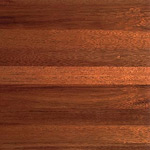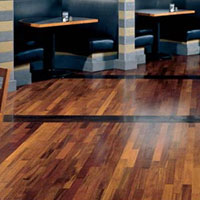Serving Upstate NY—VT—MA • For selections & prices, CALL or EMAIL US
Merbau
Wood Flooring Species
Scientific Name:
Intsia biuga / Intsia palembanica spp.
Other Names and Species:
Ipil
Kwila
Lumpha
Lumpho
Tat-talun
Vesi
Origin:
Merbau grows in the Indo-Malayan region, as well as in the Philippines, Indonesia, Australia, and many of the western Pacific islands. The word “Merbau” is the Malayan term for this wood. In the Philippines it is known as “Ipil.”
Appearance:
When freshly cut, the heartwood of merbau is a yellowish to orange-brown color, but then darkens to brown or red-brown. The grain of this coarse-textured wood varies from straight to interlocked or wavy. One of the distinctive properties of this wood is that the surface of the boards may have yellow “flecking” in the pores; thus, when finished, the wood may appear almost flecked with gold.
Properties:
Merbau is almost as stable as teak. And although comparable to hickory in strength, merbau has a much lower density. It has excellent dimensional stability and is highly resistant to termites.
Janka Hardness: 1712
Merbau is one of the hardest and most durable wood floor options. It is just under one-third harder than red oak, roughly eighteen percent harder than hard maple, and about five percent harder than wenge, and it approaches seventy-eight percent of santos mahogany’s ranking of 2200.
Workability:
This wood gums saw teeth and dulls cutting edges, so sawing is diffult, and the use of carbide tools when working merbau is recommended. It sands and finishes well and has good holding ability. Care must be taken with merbau, as contact with moisture or iron and ferrous metals can stain the wood black.
Principal Uses:
Flooring is just one of the many uses for this durable wood. It can also be found in furniture, joinery, paneling, decorative woodwork, cabinets, and musical instruments. Merbau is also a source for dyes.






